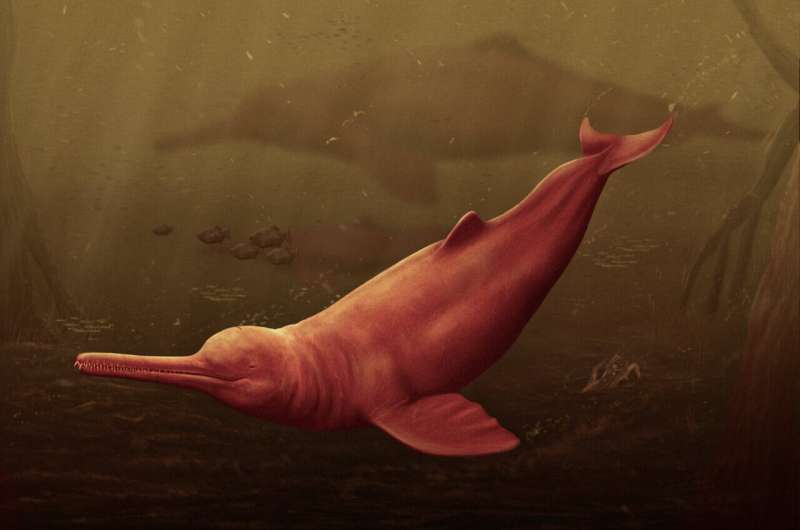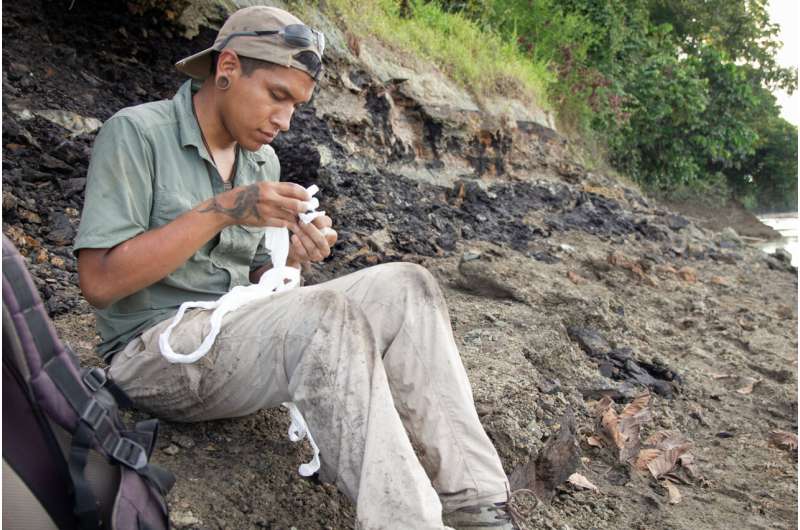This article has been reviewed according to Science X's editorial process and policies. Editors have highlighted the following attributes while ensuring the content's credibility:
fact-checked
peer-reviewed publication
trusted source
proofread
Ancient giant dolphin discovered in the Amazon

Paleontologists from the University of Zurich have announced the discovery of a new species of freshwater dolphin in the Peruvian Amazon region. Surprisingly, its closest living relatives can be found in the river dolphins of South Asia.
River dolphins are among the rarest modern cetaceans, with most extant species critically endangered. Despite their similar appearance, however, these animals are not directly related, but represent the late survivors of different cetacean groups that once inhabited our planet.
An international research team led by the University of Zurich (UZH) has now revealed the largest river dolphin ever found, measuring between 3 and 3.5 meters. The new species, named Pebanista yacuruna after a mythical aquatic people believed to inhabit the Amazon basin, was found in Peruvian Amazonia and is dated to be 16 million years old.
The findings are published in the journal Science Advances.
Changing landscape drove giant dolphin to extinction
The new dolphin species belongs to the Platanistoidea, a group of dolphins that were common in the world's oceans between 24 and 16 million years ago. The researchers believe that their originally marine ancestors invaded the prey-rich freshwater ecosystems of proto-Amazonia and adapted to this new environment.
"Sixteen million years ago, the Peruvian Amazonia looked very different from what it is today," says lead author Aldo Benites-Palomino from the Department of Paleontology at UZH. "Much of the Amazonian plain was covered by a large system of lakes and swamps called Pebas." This landscape included aquatic, semi-aquatic and terrestrial ecosystems (swamps, floodplains, etc.) and stretched across what is today Colombia, Ecuador, Bolivia, Peru and Brazil.
When the Pebas system began to give way to modern Amazonia about 10 million years ago, new habitats caused Pebanista's prey to disappear, driving the giant dolphin to extinction. This opened an ecological niche that was exploited by relatives of today's Amazon river dolphins (Inia), which were also facing extinction in the oceans due to the rise of new cetaceans, such as modern oceanic dolphins.

Findings shed light on the evolutionary history of freshwater dolphins
"We discovered that its size is not the only remarkable aspect," says Benites-Palomino. "With this fossil record unearthed in the Amazon, we expected to find close relatives of the living Amazon River dolphin—but instead the closest cousins of Pebanista are the South Asian river dolphins (genus Platanista)."
Pebanista and Platanista both share highly developed facial crests, which are specialized bony structures associated with echolocation—the ability to "see" by emitting high-frequency sounds and listening or their echoes, which they rely on heavily for hunting.
"For river dolphins, echolocation, or biosonar, is even more critical as the waters they inhabit are extremely muddy, which impedes their vision," explains Gabriel Aguirre-Fernández, a UZH researcher who also participated in this study. The elongated snout with many teeth suggests that Pebanista fed on fish, as other species of river dolphins do today.
"After two decades of work in South America we had found several giant forms from the region, but this is the first dolphin of its kind," adds Marcelo R. Sánchez-Villagra, director of the Department of Paleontology at UZH. "We were especially intrigued by its peculiar biogeographical deep-time history."
Finding fossils in the Amazon
The Amazon rainforest is one of the harshest regions for paleontological fieldwork. Fossils are only accessible during the dry season, when river levels are low enough to expose the ancient fossil-bearing rocks. If these fossils are not collected in time, the rising water levels during the rainy season will sweep them away and they will be lost forever.
The holotype—a single physical specimen on which the description and name of a new species is based—of Pebanista was found in 2018, when the lead author of the study was still an undergraduate student. The expedition, led by Peruvian paleontologist Rodolfo Salas-Gismondi, former postdoctoral fellow at the Department of Paleontology at UZH, traversed more than 300 kilometers of the Napo River.
Dozens of fossils were discovered and collected, but the biggest surprise waited at the end of the expedition, after almost three weeks of exploration: the discovery of the large dolphin skull, catalogued as MUSM 4017, which has been permanently deposited in the Museo de Historia Natural in Lima.
More information: Aldo Benites-Palomino et al, The largest freshwater odontocete: a South Asian river dolphin relative from the Proto-Amazonia, Science Advances (2024). DOI: 10.1126/sciadv.adk6320. www.science.org/doi/10.1126/sciadv.adk6320
Journal information: Science Advances
Provided by University of Zurich





















